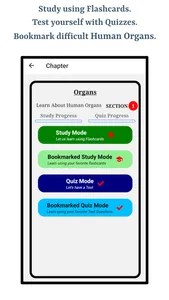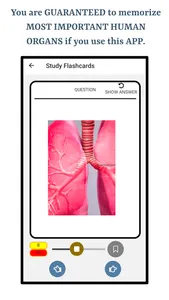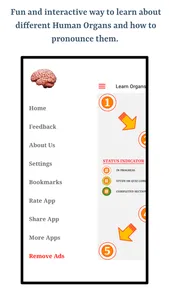This app is a great resource to memorize Most Important Human Organs. The app is engineered to make users perfect identifying different human organs by studying for a very short amount of time. Audio functionality and bookmarking is available throughout the app on chapter, section, study mode and quiz modes.
The app will help you learn the correct pronunciation of different human organs using English language. Following are the main features of this app
1. Supports pronouncing different Human Organs in English Language
2. Uses Text to Speech Engine for Audio Functionality
3. Quizzes
4. Study Mode
5. Bookmarking Study Flashcards and Quiz Questions
6. Progress Indicators for Every Chapter
7. Visualization for Overall Progress
Currently following human organs are supported
Adrenal glands
Anus
Appendix
Bladder (urinary)
Bones
Bone marrow (spongy part of the bone)
Brain
Bronchi (tubes in the lungs)
Diaphragm (muscle of breathing)
Ears
Esophagus (food pipe)
Eyes
Fallopian tubes
Gallbladder
Genitals
Heart
Hypothalamus (in the brain)
Joints
Kidneys
Large intestine
Larynx (voice box)
Liver
Lungs
Lymph nodes
Mammary glands
Mesentery (covering of the intestines)
Mouth
Nasal cavity
Nose
Ovaries
Pancreas
Pineal gland
Parathyroid glands
Pharynx
Pituitary gland
Prostate
Rectum
Salivary glands
Skeletal muscles
Skin
Small intestine
Spinal cord
Spleen
Stomach
Teeth
Thymus gland
Thyroid
Trachea
Tongue
Ureters
Urethra
Uterus
Human skeleton
Ligaments (connect muscles to bones)
Tendons (connect bones to bones)
Blood cells
Vagina
Hair
The vestibular system of the ear
Placenta
Testes
Nails
Vas deferens
Seminal vesicles
Bulbourethral glands
Male reproductive system
Scrotum
Thoracic ducts
Arteries
Veins
Capillaries
Lymphatic vessels
Tonsils (Waldeyer’s ring of tissues)
Nerves
Subcutaneous tissue
Olfactory epithelium (nose)
Cerebellum
The app will help you learn the correct pronunciation of different human organs using English language. Following are the main features of this app
1. Supports pronouncing different Human Organs in English Language
2. Uses Text to Speech Engine for Audio Functionality
3. Quizzes
4. Study Mode
5. Bookmarking Study Flashcards and Quiz Questions
6. Progress Indicators for Every Chapter
7. Visualization for Overall Progress
Currently following human organs are supported
Adrenal glands
Anus
Appendix
Bladder (urinary)
Bones
Bone marrow (spongy part of the bone)
Brain
Bronchi (tubes in the lungs)
Diaphragm (muscle of breathing)
Ears
Esophagus (food pipe)
Eyes
Fallopian tubes
Gallbladder
Genitals
Heart
Hypothalamus (in the brain)
Joints
Kidneys
Large intestine
Larynx (voice box)
Liver
Lungs
Lymph nodes
Mammary glands
Mesentery (covering of the intestines)
Mouth
Nasal cavity
Nose
Ovaries
Pancreas
Pineal gland
Parathyroid glands
Pharynx
Pituitary gland
Prostate
Rectum
Salivary glands
Skeletal muscles
Skin
Small intestine
Spinal cord
Spleen
Stomach
Teeth
Thymus gland
Thyroid
Trachea
Tongue
Ureters
Urethra
Uterus
Human skeleton
Ligaments (connect muscles to bones)
Tendons (connect bones to bones)
Blood cells
Vagina
Hair
The vestibular system of the ear
Placenta
Testes
Nails
Vas deferens
Seminal vesicles
Bulbourethral glands
Male reproductive system
Scrotum
Thoracic ducts
Arteries
Veins
Capillaries
Lymphatic vessels
Tonsils (Waldeyer’s ring of tissues)
Nerves
Subcutaneous tissue
Olfactory epithelium (nose)
Cerebellum
Show More





